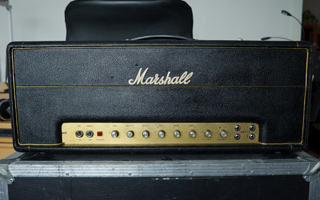




A Marshall with a built-in tremolo? Yes, such things were produced back in the day. I hadn't even seen one live before I acquired this one. It's just such a rare piece of Marshall amp history that I decided I'll have to find out if they're any good. To be frank, not too many people have praised the tremolo effect of these amps, but after a little tweaking I must say it doesn't sound all that bad. And as is the case with practically all early 70's metal panel JMP's, this thing really rocks when cranked. This is a nice example with the original footswitch - something you don't see too often.
I did a little research and it seems that this amp is actually one of the very last handwired Marshalls. A 100-watt Super Lead (s/n SL/A 6121E) once listed in the late great Amp Archives website already had a printed circuit board (PCB) and that very amp was inspected only 6 days later than mine. The aforementioned Super Lead is 154 serial numbers newer than mine. Divide that by 6 and we can quite safely approximate that Marshall was producing roughly 25 amps a day at the time. Guitar-driven rock music was becoming a big deal in the early 70's, so it comes as no surprise that there was an urgent need to speed up the production. There was no way Marshall would be able to cope with the increasing demand using old production methods.
This amp has a desirable laydown mains transformer and a wealth of those ever-delicious Mullard Mustard capacitors. This is also the very first Marshall where I have seen the serial number engraved on the chassis: it can be clearly seen next to the inspection tag above the volume pots. How long this practice was used, I really don't know, but obviously it saw daylight in 1973 at the earliest and lasted for several years. The grid wires in this amp are white as opposed to the usual green (or orange if you take a look at my '72 JMP). The amp has been fully serviced (including new electrolytic capacitors) in Jaska's Music Garage in March 2014.
Specifications
Marshall Amps Info & Schematics
s/n: T/A 5967E (September 11, 1973 is written on the inspection tag)